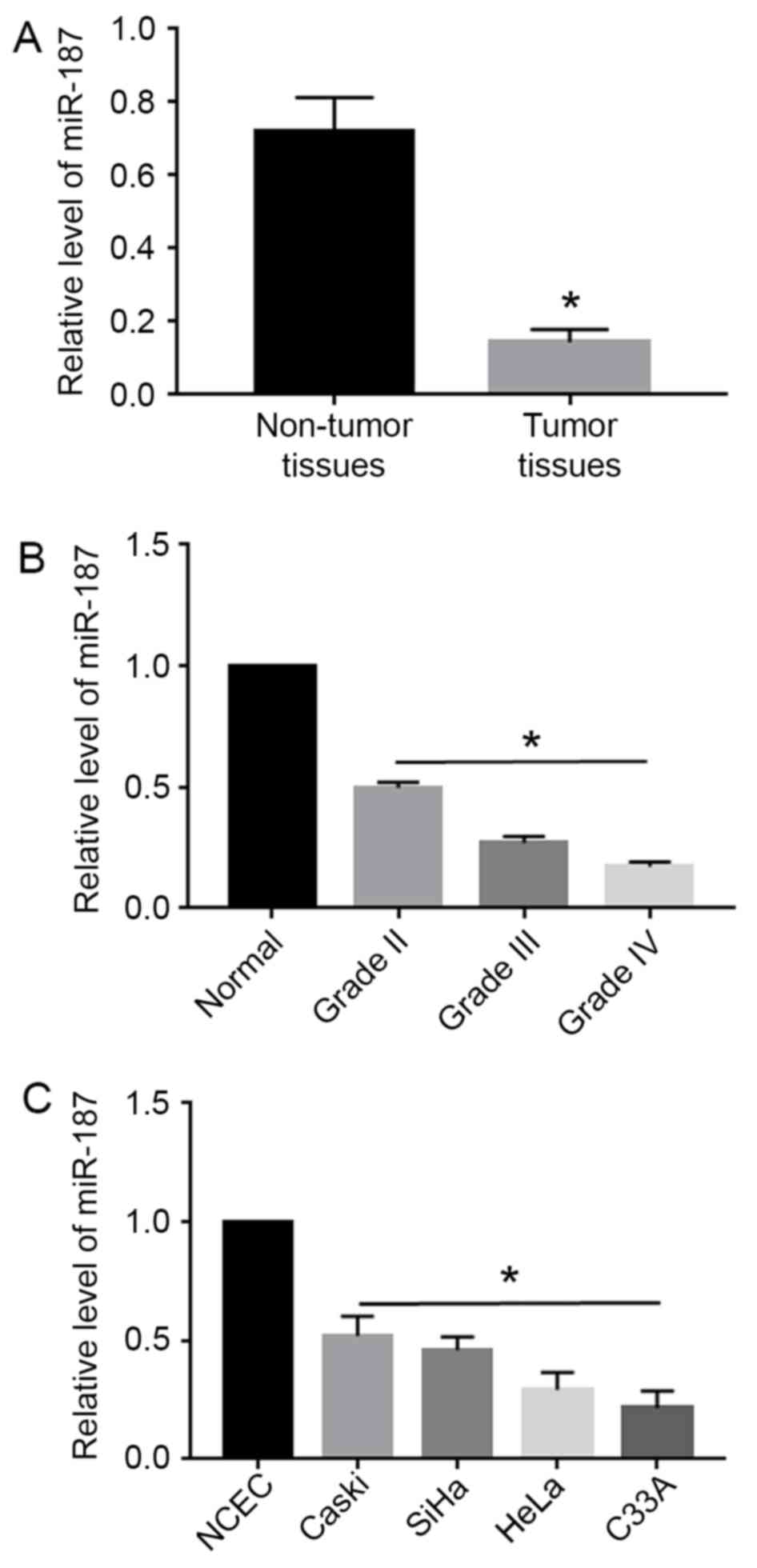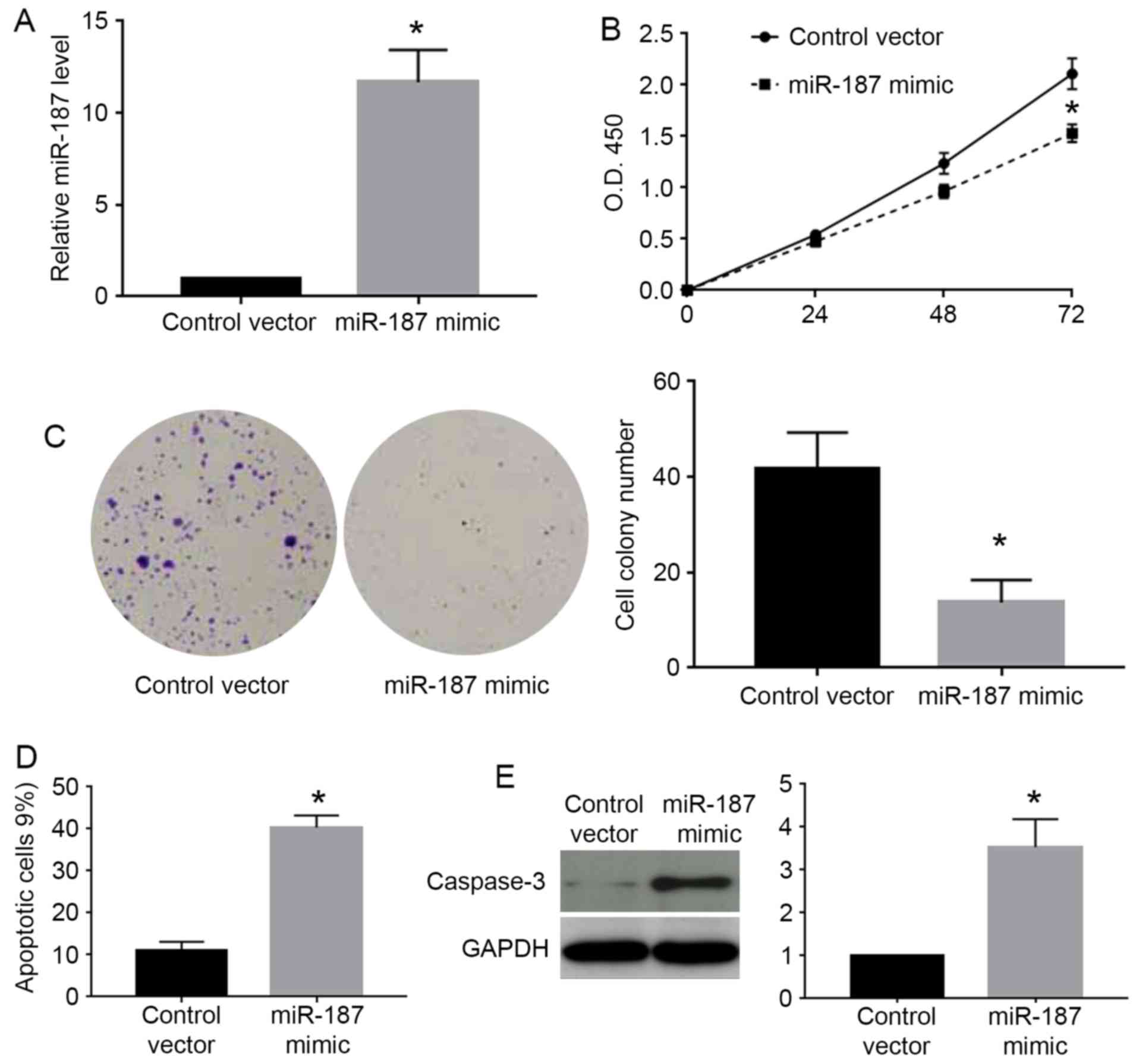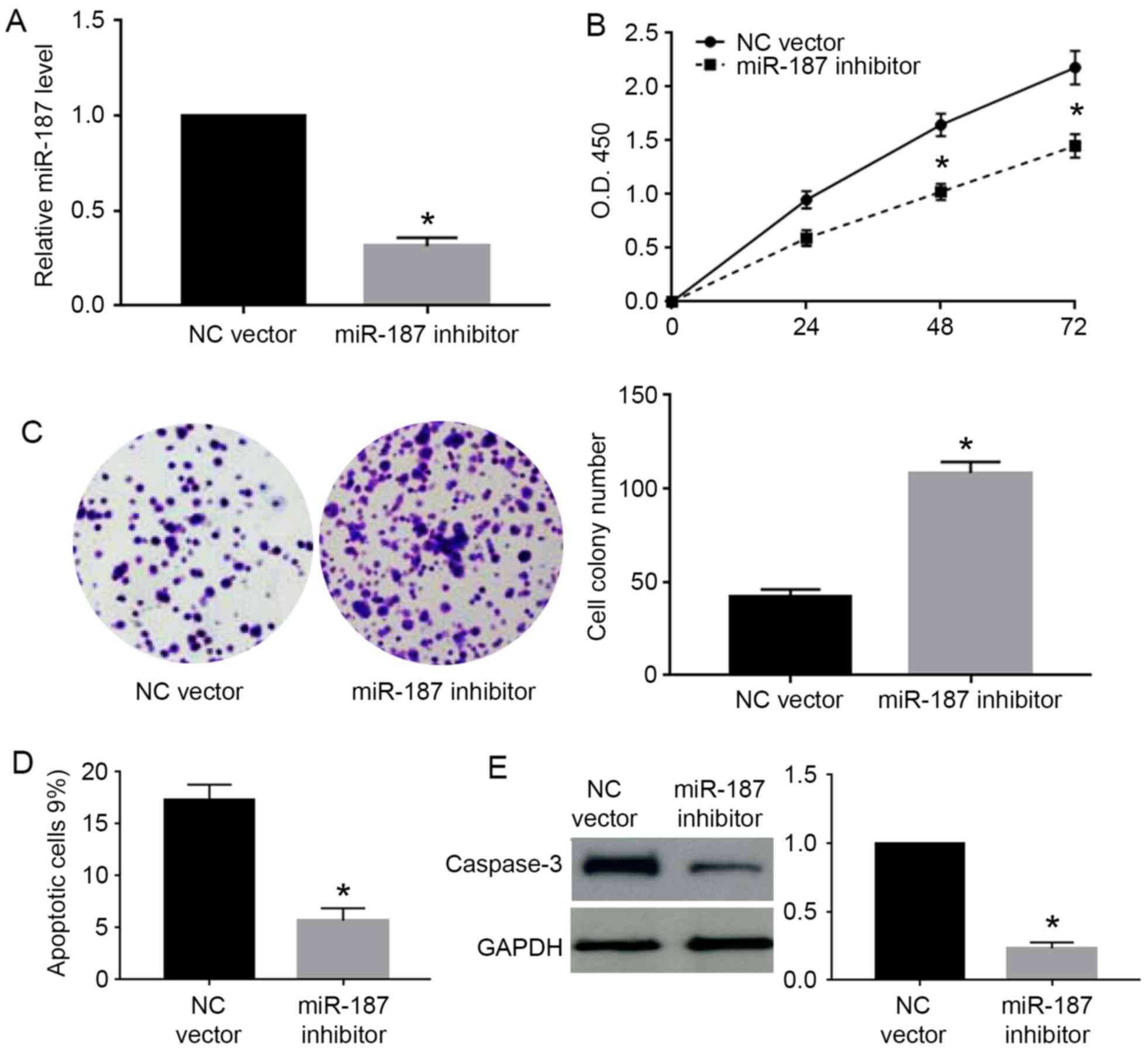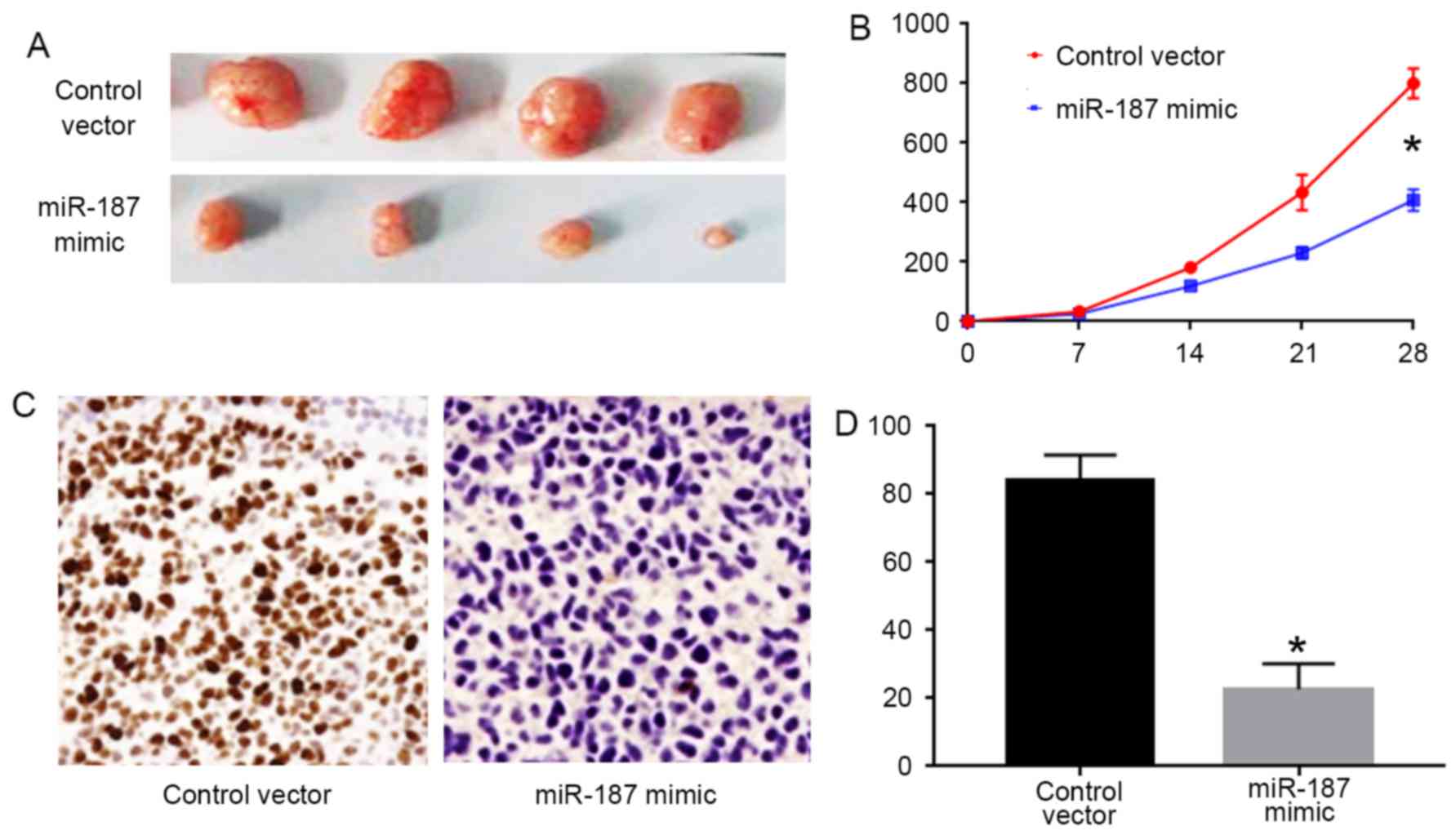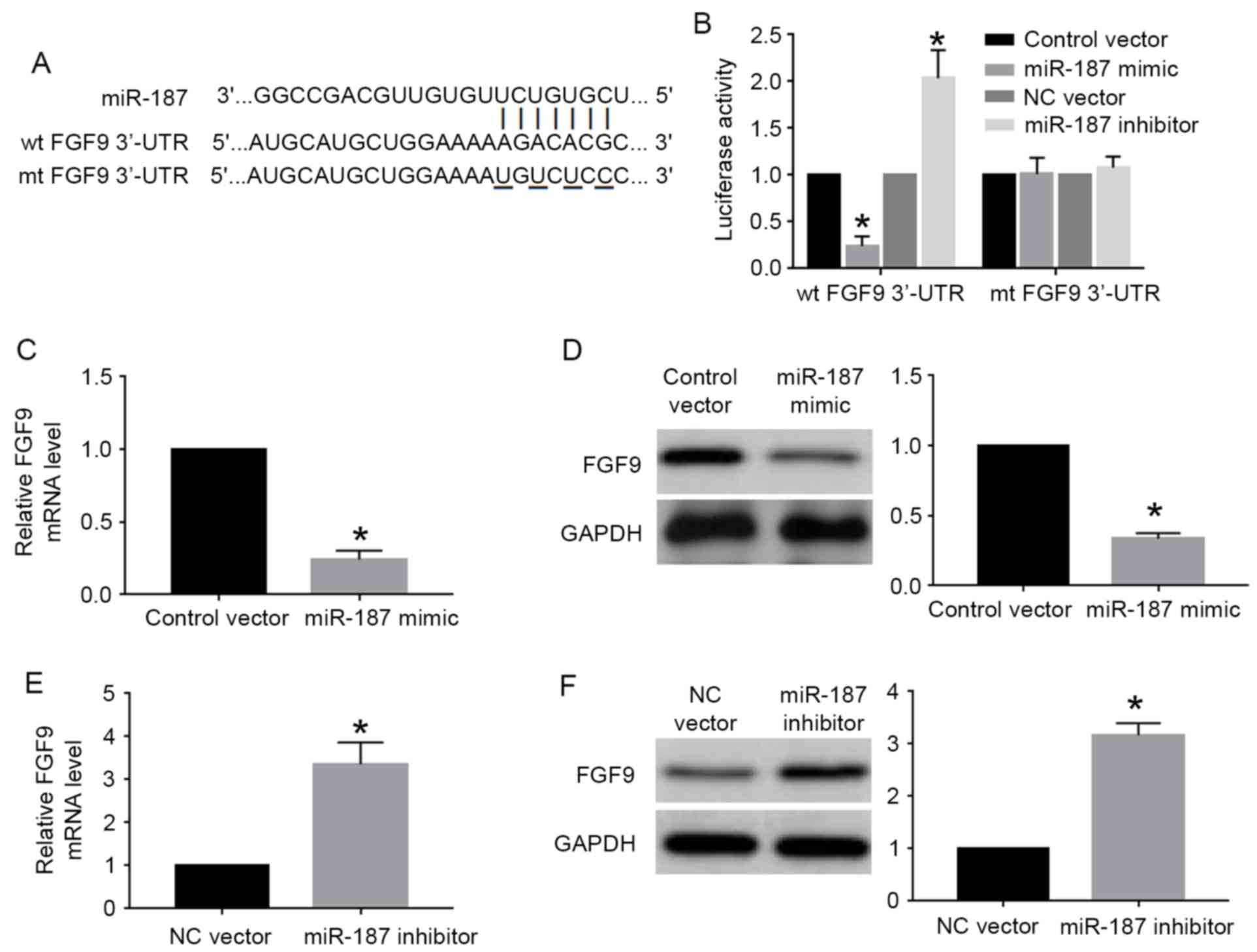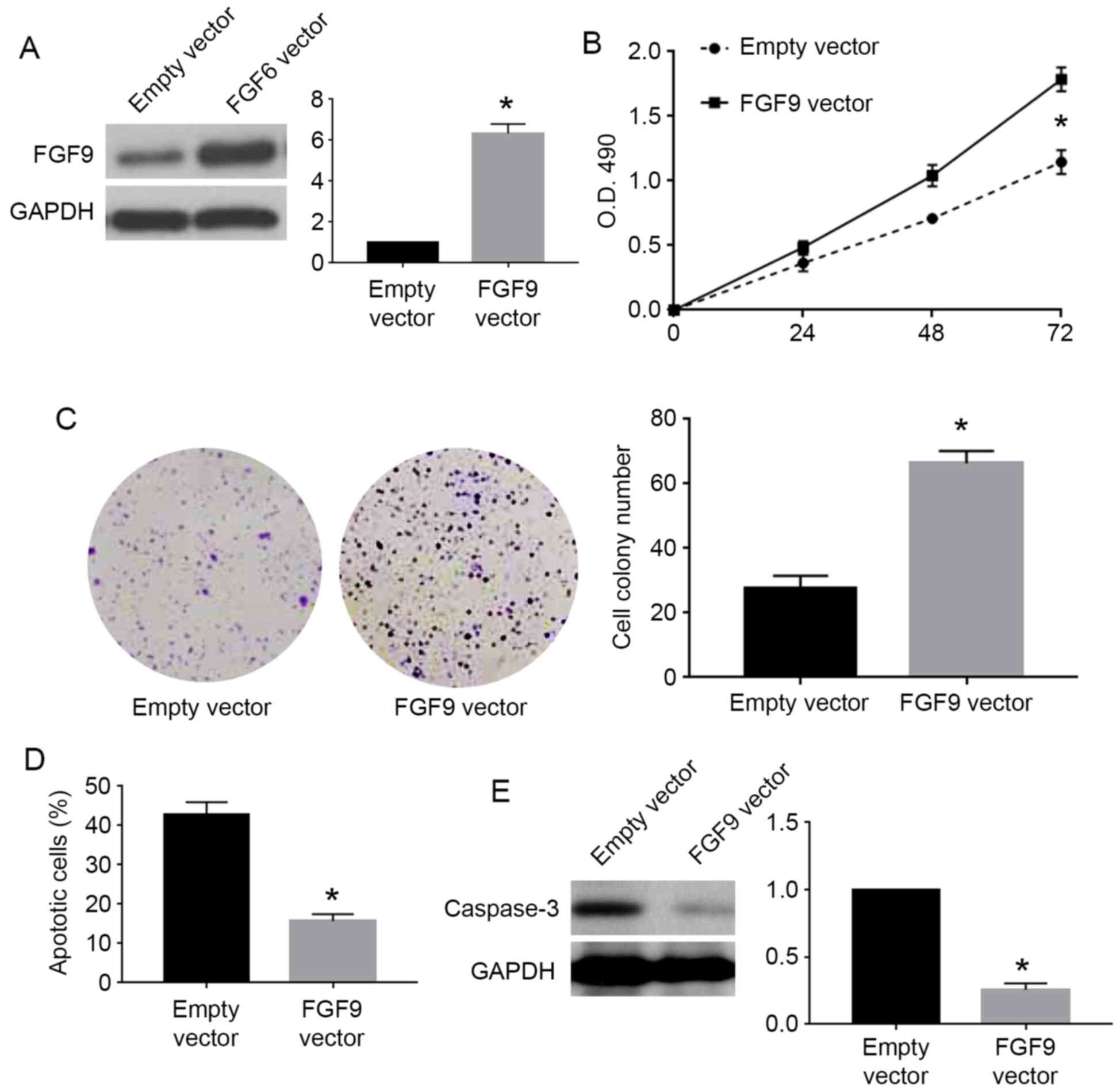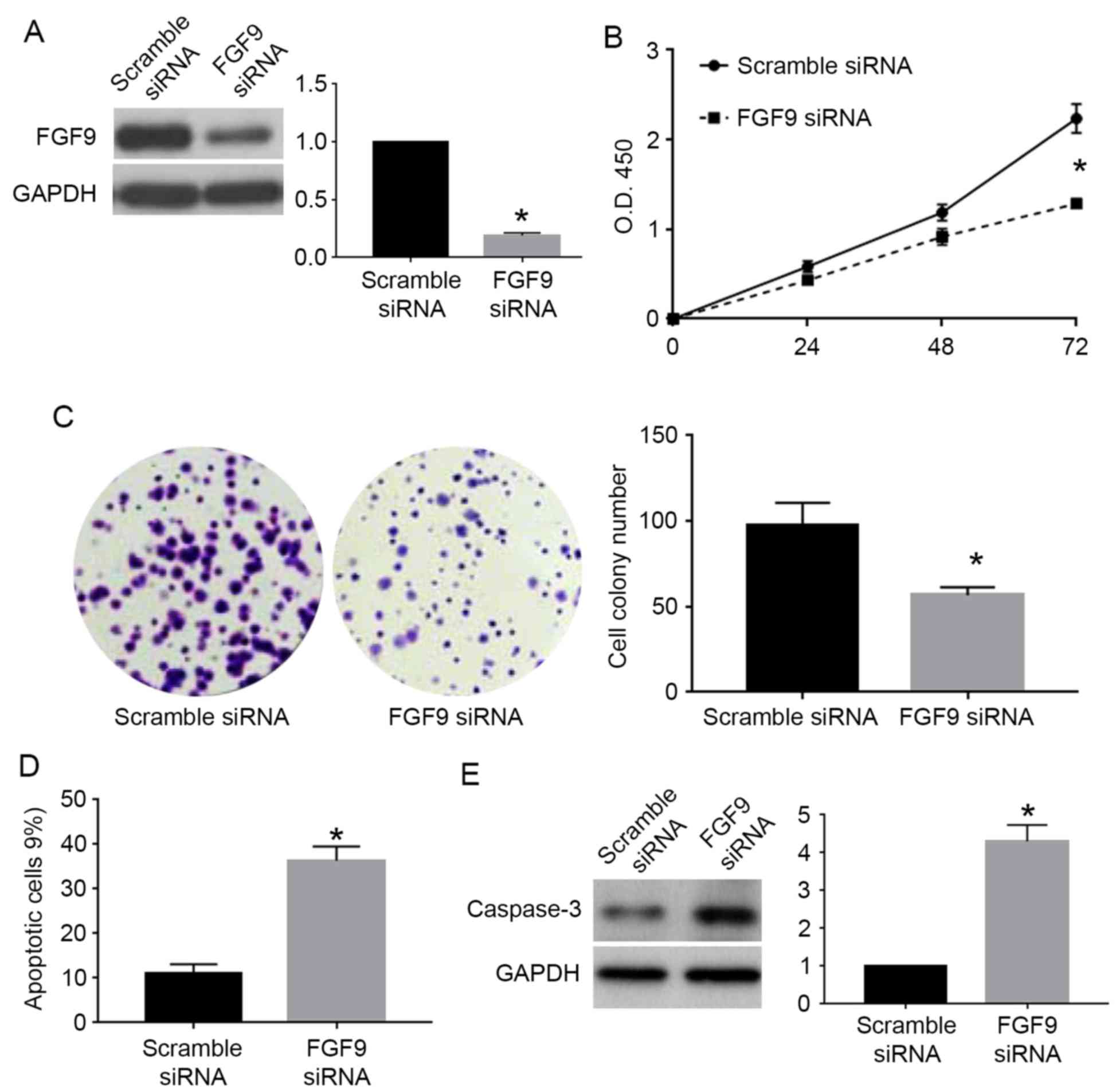miR-187 inhibits the growth of cervical cancer cells by targeting FGF9
Retraction in: /10.3892/or.2023.8632
- Authors:
- Published online on: August 23, 2017 https://doi.org/10.3892/or.2017.5916
- Pages: 1977-1984
-
Copyright: © Liang et al. This is an open access article distributed under the terms of Creative Commons Attribution License.
Abstract
Introduction
Cervical cancer, one of the most common gynecological malignant diseases, ranked fourth in all cancer-related mortalities in women, accounting for ~270,000 deaths in USA (1,2). Remarkable advances in the diagnosis and treatment of cervical cancer have been achieved, the prognosis of cervical cancer patients especially for those in advanced stage remains poor (3,4). Unfortunately, the exact molecular mechanisms underlying the initiation and progression of cervical cancer remain largely unknown. Therefore, investigating the mechanisms for the initiation and progression of cervical cancer will promote the identification of novel biomarkers and treatment targets, which is critical for improving the prognosis of cervical cancer patients.
Previous studies showed that the initiation and progression of cervical cancer is a complex process in which numerous proteins and non-coding RNAs are involved (5,6). MicroRNAs (miRNAs), a group of small non-coding RNAs, have been found to play important roles in human cancers including cervical cancer (7,8). Some miRNAs have been regarded as the biomarkers and therapeutic targets for cervical cancer patients (9). Among numerous cancer-related microRNAs, miR-187 was recently found to be a novel target in human cancers including liver (10), breast (11), ovarian (12), prostate (13), non-small cell lung (14) and colorectal cancer (15,16). It was found to play an oncogenic role in breast (11), ovarian (12) and non-small cell lung cancer (14). On the other hand, miR-187 was also found to play tumor suppressive roles in colorectal cancer (15,16), hepatocellular carcinoma (10) and prostate cancer (13). However, the expression and function of miR-187 in GC remain uninvestigated.
In the present study, we found that miR-187 was significantly decreased in cervical cancer tissues and cell lines. This study also confirmed that decreased expression of miR-187 was associated with poor clinicopathological features and poor survival of cervical cancer patients. miR-187 inhibited the proliferation and increased the apoptosis of cervical cancer cells. Furthermore, we identified that FGF9 was a downstream target of miR-187 in cervical cancers. Inhibiting FGF9 is critical for the functional influence of miR-187 in cervical cancer cells.
Materials and methods
Patients and tissue specimens
The collection of clinical samples were approved by the Research Ethics Committee of Renmin Hospital of Wuhan University. All patients enrolled in this study were pathologically confirmed as cervical cancer and were provided with written consent and agreed to donate their tissue samples for research use. These clinical samples were stored in liquid nitrogen before extracting RNAs.
Cell culture and transfection
Cervical cancer cell lines including C33A, HeLa, Caski and SiHa were cultured in Dulbecco's modified Eagle's medium (DMEM; Invitrogen, Carlsbad, CA, USA) supplemented with fetal bovine serum (10%, FBS; HyClone Laboratories, Logan, UT, USA) and penicillin/streptomycin (1%; Invitrogen). Human normal cervical epithelial cells (NCEC) were derived from healthy female cervical tissue and were cultured in serum-free medium (Invitrogen) along with EGF, bovine pituitary extract and penicillin/streptomycin (1%; Invitrogen). All cells were maintained in cell incubator at 37°C with 5% CO2. miR-187 mimic and inhibitor were obtained from Shanghai GenePharma Co., Ltd. (Shanghai, China). FGF9 vector and FGF9 siRNA were from Guangzhou Ruibo Biological Technolog, Co., Ltd. (Guangzhou, China). All these vectors were transfected into cervical cancer cells using Lipofectamine 2000 (Invitrogen) based on the provided protocols. The transfection efficiency of miR-187 mimic and inhibitor were confirmed by evaluating miR-187 level with qRT-PCR. The transfection efficiency of FGF9 vector and siRNA were confirmed by evaluating FGF9 level with western blot analysis.
Reverse transcriptase-quantitative PCR (RT-qPCR)
The RNA in cervical cancer tissues and cell lines was isolated with TRIzol reagent (Invitrogen) according to the manufacturer's instructions. Reverse transcription of miRNA and mRNA were performed with miScript II RT kit (Qiagen, Hilden, Germany) and QuantScript RT kit (Tiangen Biotech, Co., Ltd., Beijing, China), respectively. SYBR-Green PCR kit (Qiagen) was used for RT-PCR quantification. Relative miR-187 level and FGF mRNA level were calculated using 2−ΔΔCt method after normalization to U6 and GAPDH, respectively.
Western blot analysis
Cellular proteins from cervical cancer cells were extracted with RIPA buffer. Isolated proteins were subjected to electrophoresis on 4–20% SDS-PAGE gels and transferred to PVDF membranes. After blocked with 5% non-fat milk/TBST (Tris-buffered saline Tween-20), the membranes were incubated with the primary antibody including GAPDH (1:2,000; Santa Cruz Biotechnology, Santa Cruz, CA, USA), FGF9 (1:1,000; Santa Cruz Biotechnology) and caspase-3 (1:1,000; Santa Cruz Biotechnology) at 4°C overnight and incubated with HRP-conjugated secondary antibody at room temperature for 2 h. The protein bands were detected and visualized with the ECL reagent (Beyotime Institute of Biotechnology, Haimen, China).
Cell viability and proliferation assay
For viability assay, cervical cancer cells transfected with corresponding vectors were seeded in 96-well plates (5×103 cells/well). After cell seeding (0, 24, 48 and 72 h) MTT reagent was added to each well and the cells were incubated at 37°C for 4 h. After removing the culture medium, cervical cancer cells were solubilized in 150 µl dimethyl sulfoxide (DMSO) and subjected to colorimetric analysis (wavelength, 490 nm). For proliferation assay, cervical cancer cells transfected with corresponding vectors were seeded in 6-well plates and maintained in cell incubators for 2 weeks. Two weeks later, the cell colonies were stained with crystal violet solution. The number of cell colonies were counted and compared between groups.
Apoptosis assays
To evaluate the apoptosis of cervical cancer cells, the flow cytometry assay was performed to evaluate the percentage of apoptotic cells. In brief, cervical cancer cells were harvested and re-suspended in phosphate-buffered saline (PBS), and then stained with Annexin V detection kit, and subjected to FACScan analysis. Additionally, cellular level of caspase-3 which is a marker of cell apoptosis was evaluated with western blot analysis.
Luciferase reporter assay
Cervical cancer cells seeded in 24-well plates were transfected with 200 ng of miR-187 mimic or inhibitor or the corresponding control vector along with 50 ng of wild-type (WT) or mutant (MT) 3′-UTR of FGF9 mRNA. Forty-eight hours after the transfection, these cells were collected and luciferase activity was detected with a Dual-luciferase reporter assay system following the manufacturer's instructions (Promega, Madison, WI, USA).
Mouse xenograft model
To investigate the in vivo influence of miR-187 on cervical cancer cells, C33A cells transfected with miR-187 mimic or control vector were subcutaneously inoculated into nude mice. Twenty-eight days after the cell inoculation, the mice were sacrificed and the formed subcutaneous tumors were subjected to Ki-67 staining. Tumor volumes were calculated every 7 days based on the following formula: length × width2/2. The protocols for in vivo experiments were approved by the Animal Research Protection Committee of Renmin Hospital of Wuhan University.
Statistical analysis
Statistical analyses were performed using the GraphPad and SPSS 15.0 software. Comparisons between the groups were performed using the t-test and the χ2 test. Overall survival and progression-free survival analysis were performed using the Kaplan-Meier method for plotting and the log-rank test for comparison. All differences were regarded as statistically significant at the level of P<0.05.
Results
miR-187 is downregulated in human cervical cancer
Using qRT-PCR, miR-187 expression levels were evaluated in 60 pairs of cervical cancer tissues and the corresponding non-tumor tissues, as well as in cervical cancer cell lines. Compared with the non-tumor tissues, cervical cancer tissues showed significantly decreased level of miR-187 (P<0.05; Fig. 1A). Moreover, the level of miR-187 was elevated with the progression of the stage of cervical cancer (P<0.05; Fig. 1B). Additionally, miR-187 level in all cervical cancer cell lines including Caski, SiHa, HeLa and C33A was significantly decreased compared with that in the normal cervical epithelial cells (NCEC) (P<0.05; Fig. 1C).
Decreased miR-187 level is associated with poor survival of cervical cancer patients
To explore the clinical significance of miR-187 level in cervical cancer, we investigated the correlation of miR-187 expression level with the prognosis of cervical cancer patients. As shown in Fig. 2A, patients with low level of miR-187 had significantly decreased rate of overall survival (P<0.05; Fig. 2A). The data of progression-free survival demonstrated that low level of miR-187 was associated with decreased rate of progression-free survival (P<0.05; Fig. 2B), thus indicating that miR-187 could serve as a biomarker for cervical cancer patients.
miR-187 inhibits the proliferation and promotes apoptosis of cervical cancer cells
As the miR-187 level was highest in Caski cells and lowest in C33A cells, we chose Caski cells for knockdown experiments and C33A for overexpression experiments. As shown in Fig. 3A, miR-187 mimic significantly increased the expression level of miR-187 in C33A cells (P<0.05). The MTT assay showed that miR-187 overexpression significantly decreased the cell viability of C33A cells (P<0.05; Fig. 3B). Colony formation assay showed that miR-187 overexpression significantly decreased the number of formed cell colonies of C33A cells (P<0.05; Fig. 3C). On the other hand, flow cytometry assay showed miR-187 overexpression increased the percentage of apoptotic cells (P<0.05; Fig. 3D). The western blot analysis for caspase-3 demonstrated that miR-187 overexpression significantly increased the caspase-3 level in C33A cells (P<0.05; Fig. 3E). Furthermore, we performed miR-187 knockdown in Caski cells. miR-187 inhibitor significantly decreased the level of miR-187 in Caski cells (P<0.05; Fig. 4A). miR-187 knockdown significantly increased the cell viability (P<0.05; Fig. 4B) and cell colony number (P<0.05; Fig. 4C) while decreased the percentage of apoptotic cells (P<0.05; Fig. 4D) and caspase-3 level (P<0.05; Fig. 4E) in Caski cells.
miR-187 inhibits the in vivo growth of C33A cells
To confirm the in vitro effects of miR-187 on C33A cells, we performed subcutaneous injection experiments for C33A cells. As shown in Fig. 5A and B, forced expression of miR-187 in C33A cells inhibited the tumor growth in nude mice (P<0.05). Furthermore, we performed Ki-67 staining for the formed tumors. The results of Ki-67 staining showed that miR-187 overexpression significantly decreased the number of Ki-67 positive cells in the tumors (P<0.05; Fig. 5C and D).
FGF9 is the downstream target of miR-187 in cervical cancer cells
miRNA regulated cell proliferation, apoptosis and other cellular processes by interacting with the 3′-UTR site of targeted genes. FGF9, which had the complementary sequence for miR-187 binding (Fig. 6A), was one of the predicted genes of miR-187 based on the data of online database. We then performed luciferase assay for wild-type and mutant FGF9 3′-UTR to investigate whether miR-187 could interact with FGF9 3′-UTR. The results of luciferase assay showed that miR-187 overexpression significantly decreased the luciferase activity of wild-type FGF9 3′-UTR while miR-187 knockdown significantly increased that of wild-type FGF9 3′-UTR (P<0.05; Fig. 6B). Altering miR-187 level did not affect the luciferase activity of mutant FGF9 3′-UTR (Fig. 6B). Furthermore, qRT-PCR and western blot analysis showed miR-187 overexpression significantly reduced the mRNA (P<0.05; Fig. 6C) and protein (P<0.05; Fig. 6D) level of FGF9 in C33A cells. miR-187 knockdown significantly increased the mRNA (P<0.05; Fig. 6E) and protein (P<0.05; Fig. 6F) level of FGF9 in Caski cells.
Inhibiting FGF9 was critical for the biological function of miR-187 in cervical cancer cells
To confirm whether FGF9 was involved in the biological function of miR-187 in cervical cancer cells, we performed rescue experiments for FGF9 in cervical cancer cells. For C33A cells overexpressing miR-187, we used FGF9 vector to overexpress FGF9 in these cells. FGF9 vector significantly increased FGF9 expression in C33A cells overexpressing miR-187 (P<0.05; Fig. 7A). FGF9 overexpression reversed the inhibitory effects of miR-187 on cell viability (P<0.05; Fig. 7B) and colony formation (P<0.05; Fig. 7C) while blocked the promoting effects of miR-187 on apoptosis (P<0.05; Fig. 7D) and caspase-3 level (P<0.05; Fig. 7E). For Caski cells with miR-187 knockdown, we used FGF9 siRNA to inhibit FGF9 expression in these cells. FGF9 siRNA significantly reduced the expression of FGF9 in Caski cells with miR-187 knockdown (P<0.05; Fig. 8A). FGF9 knockdown in these cells significantly blocked the promoting effects of miR-187 knockdown on cell viability (P<0.05; Fig. 8B) and colony formation (P<0.05; Fig. 8C) while reversed the inhibitory effects of miR-187 knockdown on apoptosis (P<0.05; Fig. 8D) and caspase-3 level (P<0.05; Fig. 8E).
Discussion
Many studies have confirmed that miRNAs were critical players in the initiation and progression of human cancers (17–19). Accumulating evidence shows that miRNAs are promising biomarkers and therapeutic targets in cervical cancers (9). miR-187 was recently identified as a novel cancer-related miRNAs. Its expression status has been confirmed in liver (10), breast (11), ovarian (12), prostate (13), non-small cell lung (14) and colorectal cancer (15,16). Study of liver (10), ovarian (12) and colorectal cancer (15,16) suggested that miR-187 acted as a tumor suppressive factor. However, study of breast cancer and non-small cell lung cancer showed that miR-187 played oncogenic roles in these tumors (11,14). In the present study, we demonstrated for the first time that miR-187 expression level was downregulated in cervical cancer tissues and cell lines. Importantly, decreased level of miR-187 in cervical cancer patients was associated with poor prognosis of the patients. These data suggest that miR-187 has a tumor suppressive role in cervical cancer and can serve as a biomarker for cervical cancer patients.
Previous studies regarding miR-187 showed that miR-187 had different roles in different types of human cancers. miR-187 was found to inhibit the metastasis and epithelial-mesenchymal transition of liver cancer cells (10) and colorectal cancers (15,16). A study of colorectal cancer cells showed that miR-187 could also inhibit the growth of colorectal cancer cells (16). In this study, both overexpression and knockdown methods confirmed that miR-187 exerted its tumor suppressive roles in cervical cancer cells by inhibiting proliferation and prompting apoptosis of cervical cancer cells. In vivo experiments proved that miR-187 could inhibit the in vivo growth of cervical cancer cells in nude mice.
miRNAs usually have multiple downstream targets in different types of cells. Previously identified downstream targets of miRNAs include S100A4 (10), Dab2 (12), aldehyde dehydrogenase 1A3 (13) and CD276 (16). In this study, we identified that FGF9 was a novel downstream target of miR-187 in cervical cancers based on the data of luciferase assay, qRT-PCR and western blot analysis. FGF9 is well known oncogenic protein in human cancers including colon (20), ovarian (21) and lung cancer (22). Our data demonstrated that inhibiting FGF9 was critical for miR-187 exerting its suppressive effects on the growth of cervical cancer cells.
In conclusion, the present study demonstrated that miR-187 level was decreased in cervical cancer tissues and cell lines. Decreased miR-187 level in cervical cancer patients was associated with poor overall survival and progression-free survival. miR-187 inhibited the proliferation and promoted apoptosis of cervical cancer cells. In vivo experiment confirmed that miR-187 inhibited the growth of cervical cancer cells in nude mice. Furthermore, FGF9 was identified to be the downstream target of miR-187 in cervical cancer cells. Inhibition of FGF9 was required for miR-187 to exert tumor suppressive role in cervical cancer cells.
References
|
DeSantis CE, Lin CC, Mariotto AB, Siegel RL, Stein KD, Kramer JL, Alteri R, Robbins AS and Jemal A: Cancer treatment and survivorship statistics, 2014. CA Cancer J Clin. 64:252–271. 2014. View Article : Google Scholar : PubMed/NCBI | |
|
Hildesheim A and Wang SS: Host and viral genetics and risk of cervical cancer: A review. Virus Res. 89:229–240. 2002. View Article : Google Scholar : PubMed/NCBI | |
|
Bosch FX and de Sanjosé S: Chapter 1: Human papillomavirus and cervical cancer - burden and assessment of causality. J Natl Cancer Inst Monogr. 2003:3–13. 2003. View Article : Google Scholar | |
|
Smith JS, Lindsay L, Hoots B, Keys J, Franceschi S, Winer R and Clifford GM: Human papillomavirus type distribution in invasive cervical cancer and high-grade cervical lesions: A meta-analysis update. Int J Cancer. 121:621–632. 2007. View Article : Google Scholar : PubMed/NCBI | |
|
Gutschner T and Diederichs S: The hallmarks of cancer: A long non-coding RNA point of view. RNA Biol. 9:703–719. 2012. View Article : Google Scholar : PubMed/NCBI | |
|
Esquela-Kerscher A and Slack FJ: Oncomirs - microRNAs with a role in cancer. Nat Rev Cancer. 6:259–269. 2006. View Article : Google Scholar : PubMed/NCBI | |
|
Hu X, Schwarz JK, Lewis JS Jr, Huettner PC, Rader JS, Deasy JO, Grigsby PW and Wang X: A microRNA expression signature for cervical cancer prognosis. Cancer Res. 70:1441–1448. 2010. View Article : Google Scholar : PubMed/NCBI | |
|
Farazi TA, Hoell JI, Morozov P and Tuschl T: MicroRNAs in human cancer. Adv Exp Med Biol. 774:1–20. 2013. View Article : Google Scholar : PubMed/NCBI | |
|
Zhao S, Yao D, Chen J and Ding N: Circulating miRNA-20a and miRNA-203 for screening lymph node metastasis in early stage cervical cancer. Genet Test Mol Biomarkers. 17:631–636. 2013. View Article : Google Scholar : PubMed/NCBI | |
|
Dou C, Liu Z, Xu M, Jia Y, Wang Y, Li Q, Yang W, Zheng X, Tu K and Liu Q: miR-187-3p inhibits the metastasis and epithelial-mesenchymal transition of hepatocellular carcinoma by targeting S100A4. Cancer Lett. 381:380–390. 2016. View Article : Google Scholar : PubMed/NCBI | |
|
Mulrane L, Madden SF, Brennan DJ, Gremel G, McGee SF, McNally S, Martin F, Crown JP, Jirström K, Higgins DG, et al: miR-187 is an independent prognostic factor in breast cancer and confers increased invasive potential in vitro. Clin Cancer Res. 18:6702–6713. 2012. View Article : Google Scholar : PubMed/NCBI | |
|
Chao A, Lin CY, Lee YS, Tsai CL, Wei PC, Hsueh S, Wu TI, Tsai CN, Wang CJ, Chao AS, et al: Regulation of ovarian cancer progression by microRNA-187 through targeting Disabled homolog-2. Oncogene. 31:764–775. 2012. View Article : Google Scholar : PubMed/NCBI | |
|
Casanova-Salas I, Masiá E, Armiñán A, Calatrava A, Mancarella C, Rubio-Briones J, Scotlandi K, Vicent MJ and López-Guerrero JA: MiR-187 targets the androgen-regulated gene ALDH1A3 in prostate cancer. PLoS One. 10:e01255762015. View Article : Google Scholar : PubMed/NCBI | |
|
Sun C, Li S, Yang C, Xi Y, Wang L, Zhang F and Li D: MicroRNA-187-3p mitigates non-small cell lung cancer (NSCLC) development through down-regulation of BCL6. Biochem Biophys Res Commun. 471:82–88. 2016. View Article : Google Scholar : PubMed/NCBI | |
|
Zhang F, Luo Y, Shao Z, Xu L, Liu X, Niu Y, Shi J, Sun X, Liu Y, Ding Y, et al: MicroRNA-187, a downstream effector of TGFβ pathway, suppresses Smad-mediated epithelial-mesenchymal transition in colorectal cancer. Cancer Lett. 373:203–213. 2016. View Article : Google Scholar : PubMed/NCBI | |
|
Wang ZS, Zhong M, Bian YH, Mu YF, Qin SL, Yu MH and Qin J: MicroRNA-187 inhibits tumor growth and invasion by directly targeting CD276 in colorectal cancer. Oncotarget. 7:44266–44276. 2016. View Article : Google Scholar : PubMed/NCBI | |
|
Gregory RI and Shiekhattar R: MicroRNA biogenesis and cancer. Cancer Res. 65:3509–3512. 2005. View Article : Google Scholar : PubMed/NCBI | |
|
Calin GA and Croce CM: MicroRNA signatures in human cancers. Nat Rev Cancer. 6:857–866. 2006. View Article : Google Scholar : PubMed/NCBI | |
|
Hampton T: MicroRNA and metastasis. JAMA. 298:1998. 2007. View Article : Google Scholar | |
|
Fearon ER: Molecular genetics of colorectal cancer. Annu Rev Pathol. 6:479–507. 2011. View Article : Google Scholar : PubMed/NCBI | |
|
Hendrix ND, Wu R, Kuick R, Schwartz DR, Fearon ER and Cho KR: Fibroblast growth factor 9 has oncogenic activity and is a downstream target of Wnt signaling in ovarian endometrioid adenocarcinomas. Cancer Res. 66:1354–1362. 2006. View Article : Google Scholar : PubMed/NCBI | |
|
White AC, Xu J, Yin Y, Smith C, Schmid G and Ornitz DM: FGF9 and SHH signaling coordinate lung growth and development through regulation of distinct mesenchymal domains. Development. 133:1507–1517. 2006. View Article : Google Scholar : PubMed/NCBI |



